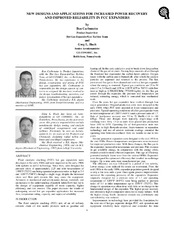| dc.contributor.other | Turbomachinery Symposium (31st : 2002) | |
| dc.creator | Carbonetto, Ben | |
| dc.creator | Hoch, Greg | |
| dc.date.accessioned | 2017-10-04T23:57:11Z | |
| dc.date.available | 2017-10-04T23:57:11Z | |
| dc.date.issued | 2002 | |
| dc.identifier.uri | https://hdl.handle.net/1969.1/163304 | |
| dc.description | Lecture | en |
| dc.description | Pg. 9-16 | en |
| dc.description.abstract | Fluid catalytic cracking (FCC) hot gas expanders were developed in the early 1960s and were improved in the early 1980s with updates in airfoil technology. Since then, units designed for pressure ratios of approximately 2.25 and inlet temperatures of pressure ratios of approximately 2.25 and inlet temperatures of 1350 F (732 C) are being operated at pressure ratios as high as 3.4 and 1400 F (760 C) through a single stage, despite the increased stress and glow path erosion this may cause the equipment. Advances in mechanical and aerodynamic design, materials, and an increase in the understanding of particle laden flows has led to the design of equipment capable of more capacity, higher efficiency, and less erosion. This paper discusses the results of redesigning several hot has expander applications for increased flow, temperature rating, capacity, and improved reliability. | en |
| dc.format.medium | Electronic | en |
| dc.format.mimetype | application/pdf | |
| dc.language.iso | en | |
| dc.publisher | Texas A&M University. Turbomachinery Laboratories | |
| dc.relation.ispartof | Proceedings of the 31st Turbomachinery Symposium | en |
| dc.subject.lcsh | Turbomachines | en |
| dc.title | New Designs And Applications For Increased Power Recovery And Improved Reliability In FCC Expanders. | en |
| dc.type.genre | Presentation | en |
| dc.type.material | Text | en |
| dc.identifier.doi | https://doi.org/10.21423/R1P375 | |


